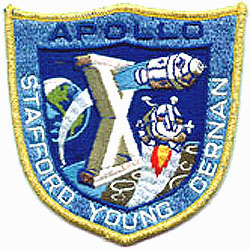
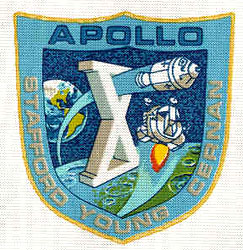
|
|


| Crew & Mission |
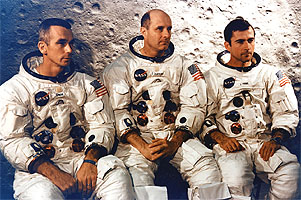 (S69-32613, 03 April, 1969) - On 13 November 1968, NASA announced that the prime crew for Apollo-10 would be: Thomas Stafford, John Young, and Eugene Cernan, with Gordon Cooper, Donn Eisele, and Edgar Mitchell as backups, and Joseph Engle, James Irwin, and Charles Duke as the support team.
(S69-32613, 03 April, 1969) - On 13 November 1968, NASA announced that the prime crew for Apollo-10 would be: Thomas Stafford, John Young, and Eugene Cernan, with Gordon Cooper, Donn Eisele, and Edgar Mitchell as backups, and Joseph Engle, James Irwin, and Charles Duke as the support team.On 18 May 1969, At 49 minutes past noon, Rocco Petrone's launch team sent Saturn-V AS-505 with CSM-106 (Charlie Brown) and LM-4 (Snoopy) from LC 39B on its way to America's second manned rendezvous with the moon. Before launch Stafford's crewmen considered not wearing their helmets and gloves for translunar injection but "chickened out," as Young phrased it, after launch and put them on. They probably found the extra garb comforting when the S-IVB fired, because the third stage again groaned and shook. None of the three were confident of being able to continue the trip much longer, and Cernan wondered how the mission could be safely aborted at this point in space. The guidance system kept Apollo 10 on a steady course, however, and they were on their way to the moon. When Stafford and Cernan were ready for undocking in Lunar Orbit they found that the LM had slipped three and a half degrees out of line with the CSM at the latching point, possibly because of loose mylar collecting on the docking ring. Whatever caused the problem, the crew feared separating the two craft might shear off some of the latching pins, possibly preventing redocking. It all worked fine and the LM seperated and flew a perfect mission over the moon. They appeared to be traveling exactly over the track they wanted, reaching a low point of 14,447 meters above the surface. Stafford and Cernan had been gone for more than eight hours when the redocked with the CSM. On 26 May 1969, Apollo 10 streaked through the early morning darkness like a shooting star, to splash down in the Pacific 690 kilometers from Samoa and only 6 kilometers from the prime recovery ship. The journey had taken 192 hours, 3 minutes, 23 seconds. A helicopter picked the crew up and carried them to the U.S.S. Princeton within the hour.
|
| The Artwork |
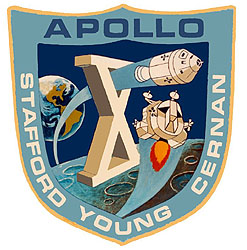 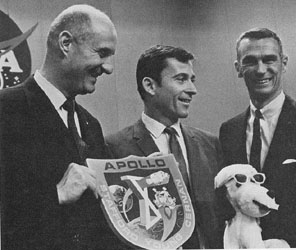
Left: April 25, 1969 -- NASA photo ID: S69-31959. Apollo 10 insignia Description: Emblem of the Apollo 10 lunar orbit mission. Right: The Apollo-X crew show their mission patch and "Snoopy" on April 26, 1969. The Apollo-10 crew picked its flight patch in March 1969. The patch displayed two craft flying above the lunar surface, with a Roman numeral X and the earth in the background. The astronauts also selected their call-signs, "Charlie Brown" for the command module and "Snoopy" for the lander. "...The Apollo-X patch was based more on the mechanics and goals of the mission than the philosophy of the space program or of the astronauts flying the mission. The big Roman Numeral X is supposed to give the three dimensional effect of sitting on the surface of the moon. The command module "Charly Brown" is in orbit as the lunar module "Snoopy" returns from its low pass over the surface of the moon. The patch was basicaly designed by the crew, primarily (John)Young and (Gene)Cernan, with a great deal of help from the artists at North American/Rockwell. North American and Grumman eventualy were the producers and primary suppliers of the patch. Although Apollo-X did not land on the moon, it was meant to indicate through the prominence of the Roman Numeral X that Apollo-X had left its permanent impression. The lunar module lent itself to the name "Snoopy" (after Charles Schulz popular cartoon strip of the day) because that is really what it was doing on Apollo-X, snooping around the lunar surface. The name "Charly Brown" for the command module seemed appropriate as the ever present companion and guardian of "Snoopy" ..."
|
| The Real Thing |
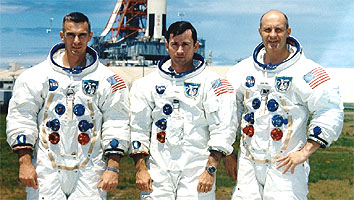
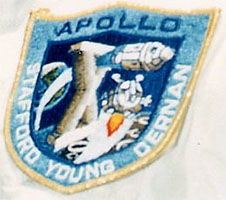
(S69-34385) The prime crew of the Apollo 10 lunar orbit mission is photographed on April 30, 1969, while at the Kennedy Space Center for pre-flight training. |
| Collecting Apollo-10 |
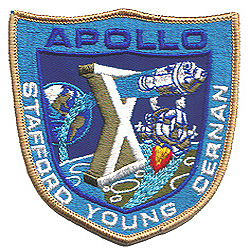 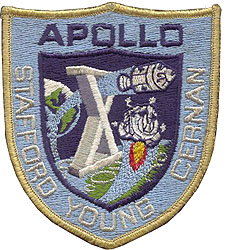 Left: Lion Brothers. Right: AB Emblem. As noted above, the official embroidered patch was probably produced by Texas Embroidery. Chances of finding such a patch for your collection are slim. The two alternates are the widely available AB Emblem or Lion Brothers versions. Lion Brothers more closely follows the original artwork and also looks most similar to the official embroidered patch. The crew could be seen wearing AB Emblem patches following splash down, however, which creates a closer relationship to the actual flight. 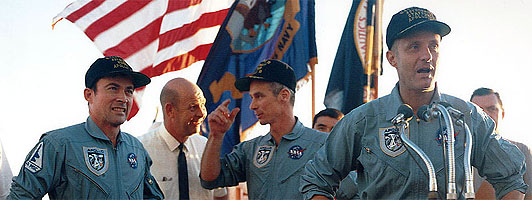 The crew wearing AB-Emblem patches following splash-down. Note that Young is also wearing an MSC T-38 patch. |